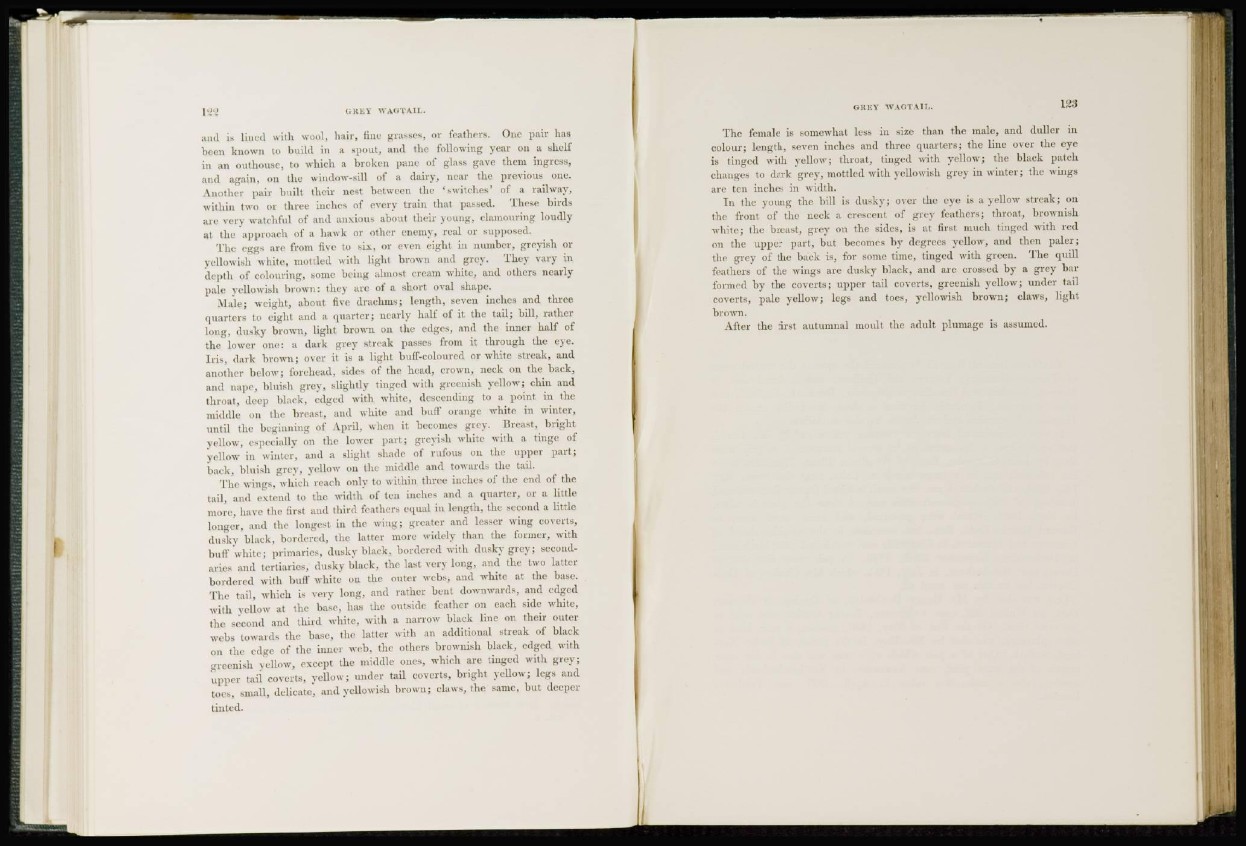
and in lined! with wool, hair, fine grasses, or feathers. One pair has
been known to build in a spout, and the following year on a shelf
in an outhouse, to which a broken pane of glass gave them ingress,
and again, on the window-sill of a dairy, near the previous one.
Another pair built their nest between the 'switches' of a railway,
within two or three inches of every train that passed. These birds
arc very watchful of and anxious about their young, clamouring loudly
at the approach of a hawk or other enemy, real or supposed,
The eggs are from five to six, or even eight in number, greyish or
yellowish white, mottled with light brown and grey. They vary in
depth of colouring, some being almost cream white, and others nearly
pale yellowish brown: they arc of a short oval shape.
.Male; weight, about five drachms; length, seven inches and three
quarters to eight and a quarter; nearly half of it the tail; bill, rather
long, dusky brown, light brown on the edges, and the inner half of
the lower one: a dark grey streak passes from it through the eye.
Iris, dark brown; over it is a light buff-coloured or white streak, and
another below; forehead, sides of the head, crown, neck on the back,
and nape, bluish grey, slightly tinged with greenish yellow; chin and
throat, deep black, edged with white, descending to a point in the
middle on the breast, and white and buff orange white in winter,
until the beginning of April, when it becomes grey. Breast, bright
yellow, especially on the lower part; greyish white with a tinge of
yellow in winter, and a slight shade of rufous on the upper part;
back, bluish grey, yellow on the middle and towards the tail.
The wings, which reach only to within three inches of the end of the
tail, and extend to the width of ten inches and a quarter, or a little
more, have the first and third feathers equal in length, the second a little
longer, and the longest in the wing; greater and lesser wing coverts,
dusky black, bordered, the latter more widely than the former, with
buff white; primaries, dusky black, bordered with dusky grey; secondaries
and tertiaries, dusky black, the last very long, and the two latter
bordered with buff white ou the outer webs, and white at the base.
The tail, which is very long, and rather bent downwards, and edged
with yellow at the base, has the outside feather on each side white,
the second and third white, with a narrow black line on their outer
webs towards the base, the latter with an additional streak of black
on the edge of the inner web, the others brownish black, edged with
greenish yellow, except the middle ones, which are tinged with grey;
upper tail coverts, yellow; under tail coverts, bright yellow; legs and
toe*, small, delicate, and yellowish brown; claws, the same, but deeper
tinted.
The female is somewhat less in size than the male, and duller in
colour; length, seven inches and three quarters; the line over the eye
is tinged with yellow; throat, tinged with yellow; the black patch
changes to dark grey, mottled with yellowish grey in winter; the wings
are ten inches in width.
In the young the bill is dusky; over the eye is a yellow streak; ou
the front of the neck a crescent of grey feathers; throat, brownish
white; the breast, grev on the sides, is at first much tinged with red
on the upper part, but becomes by degrees yellow, and then paler;
the grey of the back is, for some time, tinged with green. The quill
feathers of the wings arc dusky black, and are crossed by a grey bar
formed by the coverts; upper tail coverts, greenish yellow; under tail
coverts, pale yellow; legs and toes, yellowish brown; claws, light
brown.
After the first autumnal moult the adult plumage is assumed.